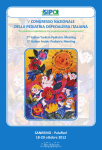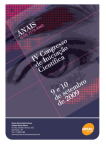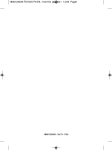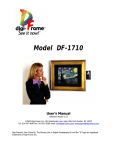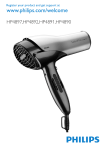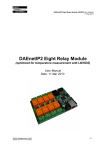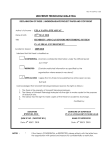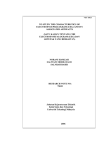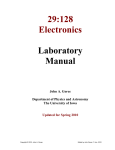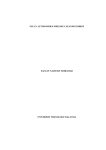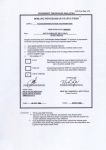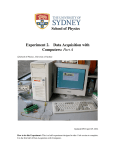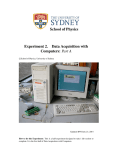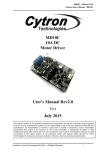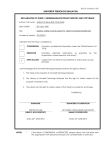Download UNIVERSITI TEKNOLOGI MALAYSIA
Transcript
PSZ 19:16 (Pind. 1/07) UNIVERSITI TEKNOLOGI MALAYSIA DECLARATION OF THESIS / UNDERGRADUATE PROJECT PAPER AND COPYRIGHT Author’s full name : SITI HASUNAH BINTI MOHAMMAD Date of birth : 31st JULY, 1987 Title : WATER TEMPERATURE SENSOR AND AUTOMATIC FEEDER NODE FOR RECIRCULATING AQUACULTURE SYSTEM Academic Session: 2009/2010 I declare that this thesis is classified as : / CONFIDENTIAL (Contains confidential information under the Official Secret Act 1972)* RESTRICTED (Contains restricted information as specified by the organisation where research was done)* OPEN ACCESS I agree that my thesis to be published as online open access (full text) I acknowledged that Universiti Teknologi Malaysia reserves the right as follows : 1. The thesis is the property of Universiti Teknologi Malaysia. 2. The Library of Universiti Teknologi Malaysia has the right to make copies for the purpose of research only. 3. The Library has the right to make copies of the thesis for academic exchange. Certified by : SIGNATURE SIGNATURE OF SUPERVISOR SITI HASUNAH BINTI MOHAMMAD (870731-52-6516) Date : NOTES : PUAN FATIMAH BINTI MOHAMAD Date : * If the thesis is CONFIDENTIAL or RESTRICTED, please attach with the letter from the organisation with period and reasons for confidentiality or restriction. “I hereby declare that I have read this thesis and in my opinion this thesis is sufficient in terms of scope and quality for the purpose of awarding the degree of Bachelor of Engineering (Electrical - Telecommunication).” Signature : …………………………………………. Name of Supervisor : PUAN FATIMAH BINTI MOHAMAD Date : …………………………………………. WATER TEMPERATURE SENSOR AND AUTOMATIC FEEDER NODE FOR RECIRCULATING AQUACULTURE SYSTEM SITI HASUNAH BINTI MOHAMMAD A report submitted in partial fulfillment of the requirements for the award of the degree of Bachelor of Engineering (Electrical - Telecommunication) Faculty of Electrical Engineering Universiti Teknologi Malaysia APRIL 2010 ii I declare that this thesis entitled “Water Temperature Sensor and Automatic Feeder Node for Recirculating Aquaculture System” is the result of my own research except as cited in the references. The thesis has not been accepted for any degree and is not concurrently submitted in candidature of any other degree. Signature : …………………………………………. Name : SITI HASUNAH BINTI MOHAMMAD Date : …………………………………………. iii Dedicated, in thankful appreciation for support, encouragement and understandings to my beloved mother, father, brother, sisters and friends. iv ACKNOWLEDGEMENT Alhamdulillah. Praise to Allah s.w.t as He guided me throughout my project, for all the help and ways He showed me till the end. My heartily gratitude goes to my supervisor, Puan Fatimah binti Mohamad for the guidance and enthusiasm given throughout the progress of this project. I would also like to express my appreciation to my family who has been so tolerant and supports me all these years. Thanks for their encouragement, love and emotional supports that they had given to me. Thanks also to my fellow team members, Faiz Asraf, Ezla Najwa and Abdul Azim for being co-operated project members. The help and support provided throughout the progress are very precious and appreciated. Nevertheless, my great appreciation dedicated to my best friends, Irdinians, Miss J, Hafiz, Shin Shishio, Yazif, Nuzrul, Fazli, Kal, Syahid, Fath, Aidil and SET member‟s batch 2006 and those who are involved directly or indirectly with this project. There is no such meaningful word than…Thank You So Much. May Allah bless you. v ABSTRACT Rearing saltwater aquaculture indoor has becoming familiar these days. “Indoor” means that the fish tanks would be inside a building instead of in the sea or outside ponds. When farming fishes indoor, many parameters must be considered to maintain the water quality. For example, the water temperature, water salinity, dissolved oxygen and pH must be properly controlled. The time to feed the fishes also should be regularly monitored as they cannot find food for themselves like in the sea. This project is constructed to provide a well-managed water quality and feeding time for Recirculating Aquaculture System (RAS). The project uses PIC 18F452 microcontroller as the main brain of the system. This microcontroller exchanges the analog and digital data between master controller and temperature sensor so that the water temperature for every two seconds are known and recorded. Any degradation of the water quality due to insufficient water temperature and feeding time causes the master controller to instruct the microcontroller to send the reliable data to relay interfacing circuit connecting to the regulator devices, which are indicated by Light Emitting Diodes (LEDs). The implemented water temperature sensor and automatic feeder node using microcontroller could improve the efficiency of Recirculating Aquaculture System. vi ABSTRAK Penternakan hidupan air masin dalam persekitaran dalaman semakin mendapat perhatian pada masa kini. Ikan akan diternak di dalam tong di dalam bangunan, berbanding di laut atau kolam. Apabila menternak ikan di kilang, banyak faktor untuk memastikan kualiti air terjaga yang perlu diambil kira. Sebagai contoh, suhu air, kemasinan air, oksigen terlarut dan pH mesti dikawal dengan sebaiknya. Ikan di dalam tong perlu diberikan makanan secara sistematik kerana ternakan tidak bebas mencari makanan sebagaimana di laut. Projek ini dijalankan untuk memastikan kualiti air dan masa pemberian makanan yang terurus bagi Sistem Akuakultur Kitar Semula (RAS). Projek ini menggunakan mikropengawal PIC 18F452 sebagai otak sistem. Mikropengawal ini berfungsi dalam penukaran data analog dan digital antara pengawal pusat dan penderia suhu supaya suhu air setiap dua saat diketahui dan direkodkan. Penurunan kualiti air akibat daripada suhu air dan masa memberi makanan yang tidak sesuai akan menyebabkan pengawal pusat menghantar arahan kepada mikropengawal untuk menghidupkan peranti yang dilambangkan dengan Diod Pemancar Cahaya (LED). Nod penderia suhu air dan pemberi makanan automatik yang dibina menggunakan mikropengawal ini berpotensi dalam meningkatkan efisiensi Sistem Akuakultur Kitar Semula. vii TABLE OF CONTENT CHAPTER 1 2 TITLE PAGE DECLARATION OF THESIS ii DEDICATION iii ACKNOWLEDGEMENT iv ABSTRACT v ABTRAK vi TABLE OF CONTENT vii LIST OF TABLES x LIST OF FIGURES xi LIST OF APPENDICES xiii INTRODUCTION 1.1 Background 1 1.2 Objective of Project 2 1.3 Scope of Project 2 1.3.1 Investigation 2 1.3.2 Programming 3 1.3.3 Circuit design and simulation 3 1.3.4 Hardware implementation 3 1.4 Outline of Thesis 4 1.5 Summary of Works 4 THEORY AND LITERATURE REVIEW 2.1 Introduction 7 viii 3 2.2 Recirculating Aquaculture System (RAS) 7 2.3 Water Temperature 8 2.4 Fish Feeding 8 2.5 Microcontroller 9 2.5.1 Pin Description of the PIC 18F452 11 2.5.2 PIC 18F452 Registers 13 2.5.2.1 OPTION_REG register 13 2.5.2.2 INTCON register 13 2.5.2.3 EECON1 register 13 2.5.2.4 T1CON register 14 2.5.2.5 ADCON0 register 14 2.5.2.6 ADCON1 register 14 2.6 Inter-integrated Circuit (I2C) 14 2.7 mikroC for PIC 16 METHODOLOGY 3.1 Introduction 18 3.2 Hardware Implementation 21 3.2.1 Starter Kit SK40C 21 3.2.2 Liquid Crystal Display JHD 162A 23 3.2.3 UIC00A USB ICSP PIC Programmer 25 3.2.4 Temperature Sensor LM35DZ 27 3.2.5 Microcontroller PIC 18F452 30 3.2.5.1 3.3 I2C Communication 32 Software Implementation 34 3.3.1 Algorithm and Programming in 34 mikroC for PIC 3.3.1.1 Processing Explanation 35 of Microcontroller Program 4 RESULT AND DISCUSSION 4.1 Introduction 41 4.2 Experiment: Study on Variation of Water 41 ix Temperature Effects to Red LED of Recirculating Aquaculture System 4.3 4.2.1 Procedures 42 4.2.2 Experimental Result Analysis 42 Experiment: Study on Feeding Time Control 45 of Recirculating Aquaculture System 5 4.3.1 Procedures 45 4.3.2 Experimental Result Analysis 45 CONCLUSION AND RECOMMENDATION 5.1 Conclusion 48 5.2 Problems 49 5.3 Recommendation 50 REFERENCES 51 APPENDICES 52 x LIST OF TABLES TABLE TITLE PAGE 1.1 Gantt chart of the project schedule for semester 1 6 1.2 Gantt chart of the project schedule for semester 2 6 2.1 Key features of PIC 18F452 compared to other PIC 10 microcontroller 3.1 Function of the labeled components of SK40C 23 3.2 Pin connection of LCD JHD 162A 24 3.3 Function of labeled components of UIC00A 26 3.4 Pin connection of PIC 18F452 in the project 30 4.1 Variation of water temperature effects to Red LED 44 4.2 Feeding controller mechanism of RAS 46 xi LIST OF FIGURES FIGURE TITLE PAGE 1.1 Project overview 5 2.1 Pin diagram of PIC 18F452 11 2.2 General I2C communication on the bus 15 2.3 mikroC for PIC software 17 3.1 Block diagram of the project 18 3.2 Flow chart of the system 19 3.3 Picture of the project 20 3.4 Starter Kit SK40C 21 3.5 Top view of SK40C 22 3.6 16X2 LCD JHD 162A 24 3.7 LCD connection on project strip board 25 3.8 UIC00A top view 26 3.9 Connection of SK40C and UIC00A USB ICSP PIC 27 programmer 3.10 Physical dimension of LM35DZ 29 3.11 Rainbow wire used to connect LM35DZ with PIC MCU 29 on SK40C 3.12 Schematic circuit of PIC 18F452 connected with added 32 components other than components which are already on SK40C board 3.13 Connection with central controller using I2C 33 communication 3.14 Flow chart of microcontroller‟s main program 35 xii 3.15 Flow chart of feeding function (interrupt) 36 3.16 MSSP block diagram (I2C mode) 37 3.17 Timer1 block diagram 39 4.1 Red LED lights on at water temperature of 18C 42 4.2 Red LED lights off at water temperature of 25C 43 4.3 Red LED lights on at water temperature of 31C 43 4.4 Initial condition of the LCD and LEDs 46 4.5 LCD and LEDs condition during fish feeding 46 xiii LIST OF APPENDICES APPENDIX TITLE PAGE A Suggested Microcontrolled Aquaculture System [2] 52 B Schematic Circuit of Cytron SK40C Board 53 CHAPTER 1 INTRODUCTION 1.1 Background Recirculating Aquaculture System (RAS) is a set of organized complementary process that allow a part of the water to leave a fish culture tank to be reconditioned and then reused in the same tank or other fish culture tanks. RAS rears fish at high densities in indoor tanks with a controlled environment. There are several water quality parameters to be well-controlled which are pH, temperature, dissolved oxygen, salinity, water flow and others. RAS can maximize the production on a limited water supply and land. It also can provide quick and effective disease control. The system also has disadvantage where the water quality would face deterioration if the water treatment process within the system are not controlled properly. This will cause disastrous losses within a short time. Thus, constant monitoring and reliable system is needed to minimize the losses due to failure in components of the system. Precise measurements and 2 controls are necessary for the success of an intensive RAS. Properly-controlled system will be energy efficient because it will minimize the use of man power especially when it comes to feeding time. The controller would be very helpful to maintain the system. To work this out, the project entitled „Water Temperature Sensor and Automatic Feeder Node for Recirculating Aquaculture System‟ has been constructed. 1.2 Objective of Project One of the objectives of the project is to exchange analog and digital data between sensors and master controller. Furthermore, this project is constructed to send the data to automatic feeder at specific time. The data sent is based on the scheduled time from master controller. The third objective is to provide reliable data so that the relay can function automatically when there is a need to change the water quality. 1.3 Scope of Project The scope of the project include the followings: 1.3.1 Investigation Related work and projects were searched and studied. By doing this, the concept of RAS and the applications of its components could be understood. Any 3 problems on the previous projects were analyzed so that improvements could be applied in this project. 1.3.2 Programming It comes to programming when dealing with PIC Microcontroller. Suitable programming software such as MPLAB IDE and mikroC for PIC can be used as a compiler for PIC Microcontroller. 1.3.3 Circuit Design and Simulation The circuit for the microcontroller would be designed and simulated using suitable software. 1.3.4 Hardware Implementation During this stage, the hardware is implemented and would be tested to detect any error. Error correction would be done to fix any problem on the hardware. 4 1.4 Outline of Thesis This thesis consists four chapters. The first chapter discusses about the objectives and scopes of this project ending with a summary of works. Theory and literature reviews that have been done were discussed in Chapter 2. The chapter introduces Recirculating Aquaculture System (RAS), the parameters of the system to be monitored, the microcontroller and the software used for the project. In Chapter 3, the discussion will be on the methodology hardware and software implementation of this project. The result and discussion will be presented in Chapter 4. Last but not least, Chapter 5 discusses the conclusion of this project and future work that can be done to improve the project in the future. 1.5 Summary of Works Implementation and works of the project are summarized into the flow chart as shown in Figure 1.1. Gantt charts as shown in Table 1.1 and Table 1.2 show the detailed works of the project that had been implemented in the first and second semester. 5 Water Temperature Sensor and Automatic Feeder Node Circuit Design Circuit implementation on bread board Circuit programming using MikroC for PIC Error Correction Circuit implementation on stripboard Interfacing with central controller Figure 1.1: Project overview 6 Table 1.1: Gantt chart of the project schedule for semester 1 NO. TASK/ACTIVITIES 1 2 FYP briefing Student-Supervisor name list out Literature review Proposal preparation and submission Study on PIC Microcontroller Survey on the price of components Attend PIC Microcontroller class Preparation for FYP 1 seminar FYP 1 seminar Preparation for FYP 1 report FYP 1 report submission 3 4 5 6 7 8 9 10 11 WEEKS 1 2 3 4 5 6 7 8 9 10 11 12 13 14 15 Table 1.2: Gantt chart of the project schedule for semester 2 NO. 1 2 3 4 5 6 7 8 TASK/ACTIVITIES Design circuit diagram Programming using related software Hardware implementation Circuit testing and error correcting Preparation for FYP 2 seminar FYP 2 seminar & demo Thesis writing Thesis draft submission WEEKS 1 2 3 4 5 6 7 8 9 10 11 12 13 14 15 16 CHAPTER 2 THEORY AND LITERATURE REVIEW 2.1 Introduction This chapter discusses the Recirculating Aquaculture System, water temperature and fish feeding time effects to the system. It also discusses briefly the microcontroller, I2C port, and mikroC for PIC. 2.2 Recirculating Aquaculture System (RAS) In a Recirculating Aquaculture System (RAS), a good water supply in both quality and quantity is essential to a successful fish farming enterprise. The required quantity of water needed to grow fish varies with the species of fish selected, size of the culture system, and investment size [1]. Fish can be grown in tanks of nearly every shape and size. Usually, fish tanks are rectangular, circular, or oval in shape and the shape influences the easiness in cleaning and water circulation. 8 2.3 Water Temperature It is known that water temperature is the strong influencer in water quality, feeding and growth rates of cultured fish. In order to maximize production, water temperature must be controlled accurately. The range of temperature for optimum aquaculture production depends on the species being cultured. The larger the volume of the water, the easier it is to control the temperature. This is because high specific heat of water creates a high thermal mass that resists rapid changes in temperature. Energy saving is one of the major advantages of RAS. Once the water tank is heated to the optimal temperature for fish growth, only a small amount of heat energy is required to maintain the temperature. However, heat loss from the building and from the water via evaporation, splash-out, or waste water must be minimized to assure economic success [1]. Heat can be provided by heating the air in the building, or directly heating the water, and by using heat exchanges [2]. Directly heating the water requires expensive insulated tanks with lids that maintain the heat, but slow down feeding and observation of the fish. Alternatives such as solar heating and heat exchangers are being considered. 2.4 Fish Feeding A complete feed containing all the essential minerals and vitamins for healthy fish growth, and formulated specifically for the fish species being reared, is necessary for fish production in the system. It is recommended to feed a commercial feed of dry, floating pellets so that the feeding activity and health of the fish can be 9 easily observed at the water surface. The size of the pellets should correspond with the size of the fish. Cultured fish generally are fed three to five percent of their body weight or all the feed that they can consume in a short period of time, say five minutes. Feed remaining in the tank after five minutes is seldom eaten and overfeeding can seriously degrade water quality. A good, quick indicator of problems with water quality or disease is when fish go off feed or refuse to eat. Feeding rates would reduce at very high and low water temperatures. To maximize growth, fish feeding must be done on a regular schedule at the same time each day. More regular feedings (several times per day) have resulted in better growth rates and feed conversion efficiencies than a single daily feeding. Automatic feeders and demand feeders can be used in commercial operation to reduce labor costs. 2.5 Microcontroller Microcontrollers are general purpose microprocessors which have additional parts that allow them to control external devices. A microcontroller is a very powerful tool that allows a designer to create sophisticated I/O data manipulation algorithms. The simplest microcontroller architecture consists of a microprocessor, memory, and I/O. The microprocessor consists of a central processing unit (CPU) ant the control unit (CU). Memory is the important part of a microcomputer system. There are basically five types of memories: a) Random Access Memory (RAM) b) Read Only Memory (ROM) c) Erasable Programmable Read Only Memory (EPROM) 10 d) Electrically Erasable Programmable Read Only Memory (EEPROM) e) Flash EEPROM The PIC families of microcontrollers are developed by Microchip Technology Inc. PIC microcontrollers have simple architectures and there are many versions of them, some with only small enhancements and some offering more features. In this project, the microcontroller used is PIC 18F452 (please refer Figure 6 in Appendices for PIC 18F452 block diagram). Key features of this microcontroller are as stated in Table 2.1. Table 2.1: Key features of PIC 18F452 compared to other PIC microcontrollers 11 2.5.1 Pin Description of the PIC 18F452 Basically, this microcontroller is a 40-pin device with the following pins: MCLR Master clear input. RB4 – RB7 Bi-directional port B pins. Some of these pins are also used as programming pins. RB0 – RB2/ Bi-directional port B pin. Also, external interrupt pin. INT0 – INT2 RB3/CCP2 Bi-directional port B pin. Also, Capture2 input/Compare2 output/PWM2 output. Figure 2.1: Pin diagram of PIC 18F452 RA0 – RA1 Bi-directional port A pins. Also, analog input pins. RA2 Bi-directional port A pin. Also, analog input pin and analog negative reference voltage. RA3 Bi-directional port A pin. Also, analog input pin and analog positive reference voltage. RA4 Bi-directional port A pin. Also, clock input to Timer0 module. 12 RA5 Bi-directional port A pin. Also, analog input and synchronous serial port slave select pin. RE0 – RE2 Bi-directional port E pins. Also analog inputs and parallel slave port control pins. RD0 – RD7 Bi-directional port D pins. Also, parallel slave bus I/O pins. VSS Ground reference. VDD Positive supply voltage. OSC1 – OSC2 Oscillator crystal inputs. RC0 Bi-directional port C pin. Also, Timer1 oscillator output or Timer1 clock input. RC1 Bi-directional port C pin. Also, Timer1 oscillator input or Capture2 input/Compare2 output/PWM2 output. RC2 Bi-directional port C pin. Also, Capture1 input/Compare1 output/PWM1 output. RC3 Bi-directional port C pin. Also, synchronous serial clock input/output for SPI/I2C mode. RC4 Bi-directional port C pin. Also, the SPI Data In and I2C Data I/O. RC5 Bi-directional port C pin. Also SPI Data Out. RC6 Bi-directional port C pin. Also, USART asynchronous transmit or synchronous clock. RC7 Bi-directional port C pin. Also, USART asynchronous receive or synchronous data. The amount of program memory provided by the PIC 18F452 should be sufficient for many temperature monitoring and control applications. These applications also need large data memories since most of the operations use noninteger, floating point arithmetic, requiring several bytes to store a single variable in the data memory. 13 2.5.2 PIC 18F452 Registers The device has a large number of registers with many options and some of the important registers are described below: 2.5.2.1 OPTION_REG register This is a readable and writable register, which contains various control bits to configure the Timer0/watchdog prescaler, Timer0 clock source, port B pull-up enable bits, and external interrupt edge-trigger. 2.5.2.2 INTCON register INTCON register is a readable and writable register contained various enable and flag bits for the Timer0 register, port B interrupt enable bits, peripheral interrupt enable bit, and the global interrupt enable bit. 2.5.2.3 EECON1 register This is the EEPROM memory control register. The register contains the enable bits for EEPROM write, read, enable, and EEPROM error flag bits. 14 2.5.2.4 T1CON register This is the Timer1 control register which contains the bit definitions for Timer1 clock source, oscillator enable control bit, and Timer1 prescaler select bits. 2.5.2.5 ADCON0 register This register controls the operation of the A/D module. The bits in this register select the A/D clock source, one of eight analog channels, and the A/D status. 2.5.2.6 ADCON1 register Register ADCON1 configures the function of the A/D port pins and selects the A/D format. 2.6 Inter-integrated Circuit (I2C) I2C is a multi-master computer bus which uses only two bidirectional opendrain lines, Serial Data (SDA) and Serial Clock (SCL). More than one IC capable of initiating a data transfer can be connected to it. The I2C protocol specification states 15 that the IC that initiates a data transfer on the bus is considered the Bus Master. Thus, at that time, all the other ICs are regarded to be Bus Slaves. Typical voltages used are +5 V or +3.3 V. The I²C reference design has a 7bit address space with 16 reserved addresses, so a maximum of 112 nodes can communicate on the same bus. Common I²C bus speeds are the 100 kbit/s standard mode and the 10 kbit/s low-speed mode, but arbitrarily low clock frequencies are also allowed. Every device hooked up to the bus has its own unique address, no matter whether it is an MCU, LCD driver, memory, or ASIC. Each of these chips can act as a receiver and/or transmitter, depending on the functionality. Obviously, an LCD driver is only a receiver, while a memory or I/O chip can be both transmitter and receiver. Consider the following setup in Figure 2.2 and assume the MCU wants to send data to one of its slaves. Figure 2.2: General I2C communication on the bus First, the MCU will issue a START condition. This acts as an 'Attention' signal to all of the connected devices. All ICs on the bus will listen to the bus for incoming data. 16 Then the MCU sends the ADDRESS of the device it wants to access, along with an indication whether the access is a Read or Write operation (Write in our example). Having received the address, all IC's will compare it with their own address. If it doesn't match, they simply wait until the bus is released by the stop condition (see below). If the address matches, however, the chip will produce a response called the ACKNOWLEDGE signal. Once the MCU receives the acknowledge, it can start transmitting or receiving DATA. In our case, the MCU will transmit data. When all is done, the MCU will issue the STOP condition. This is a signal that the bus has been released and that the connected ICs may expect another transmission to start any moment. 2.7 mikroC for PIC Figure 2.3 shows the view of mikroC for PIC (mikroC) software used in the project. mikroC is a powerful, feature rich development tool for PIC microcontrollers. It provides a successful match featuring highly advanced IDE, ANSI compliant compiler, broad set of hardware libraries, comprehensive documentation and plenty of ready-to-run examples. 17 Code Explorer Code Editor Error Window Figure 2.3: mikroC for PIC software mikroC allows quick development and deployment of complex applications. It enables C source code writing using highly advanced Code Editor. The included mikroC libraries could be used to speed up the development of data acquisition, memory, displays, conversions, and communications. Code Explorer helps user to monitor the program structure, variables, and functions. Any programmers could be used to generate the commented, human-readable assembly and standard HEX. Plenty of examples are also provided to be expanded, developed and used as building bricks in user‟s projects [6]. CHAPTER 3 METHODOLOGY 3.1 Introduction In this project, microcontroller will be used as the controller to control the temperature sensor and feeder node. The block diagram of the system is shown in Figure 3.1. Master Controller Buzzer Switch Green LED (function indicator) PIC Microcontroller AnalogDigitalConverter LCD Yellow LED (feeder indicator) Red LED (temperature indicator) Figure 3.1: Block diagram of the project Sensor 19 PIC Microcontroller is the main component of this project. The PIC Microcontroller is programmed to check the temperature of the water whether it is in the suitable range or not. The sensor which would be in the water will sense the temperature of the water. These data would then be received by the microcontroller. Any out-of-range temperature would switch on the Red Light Emitting Diode (LED). The Liquid Crystal Display (LCD) would display the current temperature for every two seconds. The feeder is indicated by the yellow LED and buzzer and it depends on the master controller to function as the master controller has the time set for automatic fish feeding. The green LED indicates the functionality of the circuit. The PIC Microcontroller would send the data to the master controller through Interintegrated Circuit (I2C) serial bus. Figure 3.2: Flow chart of the system 20 According to Jacques Esparza, Adrian Lopez and Karla Montejano in their research entitled “Microcontroller-based Aquatic Ecosystem”, the level for temperature is between 72˚ to 82˚ F which is 22˚ to 28˚ C. Fish feeding must be done once or twice daily with five minutes amount per feeding time. The system would make sure that the level of temperature would be within this range. Any insufficient level of that parameter would direct the system according to the flow in Figure 3.2. Figure 3.3 shows the picture of the project. The project is divided into two parts which are hardware and software implementation. Each part of the project will be discussed in the following section. DC Power Adaptor Buzzer LCD LEDs LM35DZ PIC18F452 SK40C I2C Communication Link Figure 3.3: Picture of the project 21 3.2 Hardware Implementation This section will discuss about components that had been used in the project. The components included Starter Kit SK40C, LCD, UIC00A USB ICSP PIC programmer, temperature sensor LM35DZ, microcontroller PIC 18F452, and I2C communication link. 3.2.1 Starter Kit SK40C Figure 3.4: Starter Kit SK40C Figure 3.4 shows the starter kit SK40C used in this project. It is an enhanced 40 pins PIC microcontroller start up kit created by Cytron Technologies Sdn. Bhd. It 22 is designed to offer an easy to start board for PIC MCU user. This board comes with basic element for user to begin project development [7]. With dimension of 85mm x 55mm, it is perfectly fit for 40 pins 16F and 18F PIC. SK40C comes with additional features: a) 2 x Programmable switch b) 2 x LED indicator c) Turn pin for crystal d) LCD display (optional) e) UART communication f) USB on board The function of PIC could be easily utilized by directly plugging in the I/O components in whatever way that is convenient to user. It also has the UIC00A connector on board, which can help user to start developing project right away using the programmer. Figure 3.5 shows the top view of SK40C and Table 3.1 shows the function of the components labeled in Figure 3.5. E F H I G C J B N K A M O P Figure 3.5: Top view of SK40C L 23 Table 3.1: Function of the labeled components of SK40C Label Function A DC power adaptor socket B USB connector C Toggle switch for power supply D Power indicator LED E Connector for UIC00A programmer F LED indicator G Header pin and turn pin H UART connector I Programmable push button J Reset button K LCD contrast L JP8 for LCD backlight M JP9 for USB N 40 pin IC socket for PIC MCU O Turn pin for crystal P LCD display The starter kit SK40C is soldered onto the strip board to make connection with other components required in the project. The voltage which is input through DC power adapter socket labeled by A should be ranged from 7 to 15V. The already-on-board voltage regulator then regulates the voltage to 5V. 3.2.2 Liquid Crystal Display JHD 162A 16 characters X 2 rows Liquid Crystal Display (LCD) JHD 162A is used in the project to display the current water temperature value. The LCD has 16 pins as shown in Figure 3.6. The function of each pin is shown in Table 3.2. 24 Figure 3.6: 16X2 LCD JHD 162A Supply voltage for this LCD is within 4.5 – 5.5V. The LCD must be soldered until the joint is fully covered to make sure that the LCD is well-functioned. Sometimes, the LCD cannot display the alphanumeric characters on its display because it is not well-soldered onto the strip board. Table 3.2: Pin connection of LCD JHD 162A Pin Name Pin function 1 GND Ground 2 VDD Positive supply for LCD 3 Con 4 RB4 5 6 7 8 9 10 11 12 13 14 15 16 GND RB5 RD0 RD1 RD2 RD3 RD4 RD5 RD6 RD7 VDD B/L Brightness adjust Select register, select instruction or data register Ground Start data read or write LCD Data bus pin LCD Data bus pin LCD Data bus pin LCD Data bus pin LCD Data bus pin LCD Data bus pin LCD Data bus pin LCD Data bus pin Backlight positive input Backlight negative input Connection GND 5V Connected to a potentiometer to adjust brightness Pin RS of LCD GND Pin E of LCD Pin D0 of LCD Pin D1 of LCD Pin D2 of LCD Pin D3 of LCD Pin D4 of LCD Pin D5 of LCD Pin D6 of LCD Pin D7 of LCD VDD Connect to JP8 25 SK40C provides ports for LCD connection, but manual connection using jumpers on strip board is preferred in this project as shown in Figure 3.7. The brightness of the display can be controlled by using potentiometer. In this project, the potentiometer used is variable resistor B10K. LCD Brightness Control Pin 16 Pin 1 Figure 3.7: LCD connection on project stripboard 3.2.3 UIC00A USB ICSP PIC Programmer Figure 3.8 shows the UIC00A USB ICSP PIC programmer built by Cytron Technologies Sdn. Bhd. with the components labeled function in Table 3.3. The programmer is designed to program popular Flash PIC MCU which includes PIC12F, PIC16F and PIC18F family. On board In Circuit Serial Programming (ICSP) connector offers flexible method to load program. On board programming 26 helps eliminates the frustration of plug-in and plug-out of PIC MCU, so the source code can be quickly programmed and debugged while the target PIC is on the development board. A E B C D Figure 3.8: UIC00A top view Table 3.3: Function of labelled components of UIC00A Label A B C D E Function Mini USB port socket Switch to initiate write device programming Main power supply indicator LED (green) Busy indicator LED (red) IDC Box Header for programming connector Mini USB socket at “A” is for USB connections to PC desktop or laptop. Mini header of USB cable that comes with UIC00A package must be connected to this socket. UIC00A obtained its power directly from USB connection. Therefore no power supply is required, making it a portable programmer [8]. UIC00A is compatible with Microchip‟s PICkit 2, programming software used to load the HEX code into the PIC MCU. 27 Figure 3.9 shows the connection of SK40C with UIC00A. The USB cable is connected as mentioned above before continuing with the software installation for first time usage. The software installer also comes with UIC00A package. One side of programming cable is connected to box header of UIC00A and the other side to box header of SK40C to be programmed. External power is used to supply SK40C because UIC00A cannot support large power usage. Programming cable Figure 3.9: Connection of SK40C and UIC00A USB ICSP PIC programmer 3.2.4 Temperature Sensor LM35DZ LM35DZ is one of precision centigrade temperature sensors. The LM35 series are precision integrated-circuit temperature sensors, whose output voltage is nearly proportional to the Celsius (Centigrade) temperature. It does not require any 28 external calibration to provide typical accuracies of ±¼C at room temperature and ±¾C over a full -55 to +150C temperature range. The features of LM35DZ are as follows: a) Calibrated directly in Celcius (Centigrade). b) Linear +10.0 mV/C scale factor. c) 0.5C accuracy guaranteeable (at +25C). d) Rated for full -55 to +150C range. e) Suitable for remote applications. f) Low cost due to wafer-level trimming. g) Operates from 4 to 30 volts. h) Less than 60 µA current drain. i) Low self-heating, 0.08C in still air. j) Nonlinearity only ±¼C typical. k) Low impedance output, 0.1 Ω for 1mA load. Figure 3.10 shows the physical dimension of LM35DZ. It can be glued or cemented to a surface and its temperature will be within about 0.01C of the surface temperature. In this project, the rainbow wire is used to connect the temperature sensor with PIC MCU on SK40C as shown in Figure 3.11. The pins of LM35DZ must not be connected to each other by covering each of them with insulated tape to avoid short-circuited. 29 +VS VOUT GND TOP VIEW Figure 3.10: Physical dimension of LM35DZ Figure 3.11: Rainbow wire used to connect LM35DZ with PIC MCU on SK40C 30 To immerse this temperature sensor in the water, it must be mounted inside a sealed-end metal tube or screwed into a threaded hole in a tank. Alternatively, there are many ways to make LM35DZ water proof and one of them is to use an empty modified pen tube. As with any IC, the LM35DZ and accompanying wiring and circuits must be kept insulated and dry to avoid leakage and corrosion. 3.2.5 Microcontroller PIC 18F452 The microcontroller acts like the brain of the water temperature sensor and automatic feeder node of RAS. The microcontroller chip that has been selected for the purpose of controlling the speed of DC motor is PIC 18F452 manufactured by Microchip. This chip is selected based on several reasons: a) Its size is small and equipped with sufficient output ports without having to use a decoder or multiplexer. b) Its portability and low current consumption. c) It can be programmed and reprogrammed easily (up to 1,000,000 cycles) using UIC00A USB ICSP PIC Programmer. d) It has wide operating voltage range (2.0V to 5.5V). Refer to Table 3.4 for the pin connection of PIC 18F452 in water temperature sensor and automatic feeder node for RAS. Pins that are not stated in the table are not used and are left hanging. Pin Name VDD VSS OSC1 OSC2 Table 3.4: Pin connection of PIC 18F452 in the project Pin No. Description Application Positive supply 11,32 Power supply to chip (+5V) 12,31 Ground reference Ground reference 13 For oscillator or Connected to resonator resonator 20MHz 14 31 MCLR 1 Reset input RA0 2 Input/Output pin RB4 RB5 19-22, 27-30 37 38 RC0 15 Input/Output pin RC1 16 Input/Output pin RC2 17 Input/Output pin RC3 18 Serial clock (SCL) RC4 23 Serial data (SDA) RC6 25 Input/Output pin RD0–RD7 Always connected to +5V Input of VOUT from LM35DZ as temperature sensor Input/Output pin LCD data bus pin (D0-D7) Input/Output pin Input/Output pin Pin RS of LCD Pin E of LCD Temperature level indicator (Red LED) Feeding time indicator (Yellow LED) Circuit function indicator (Green LED) SCL pin for I2C communication link SDA pin for I2C communication link Buzzer Figure 3.12 shows the schematic circuit of microcontroller PIC 18F452 connected with added components other than components which are already on SK40C board (see APPENDIX B for schematic circuit of SK40C). At the beginning, microcontroller will receive temperature value from LM35DZ through RA0 of PIC 18F452. The detected temperature from LM35DZ will feedback to Red LED through RC0 of PIC 18F452. The microcontroller will operate as was programmed (detail program at section 3.3.1) to display the temperature value on the LCD for every two seconds and to switch on Yellow LED and buzzer during feeding time. 32 Figure 3.12: Schematic circuit of PIC 18F452 connected with added components other than components which are already on SK40C board 3.2.5.1 I2C Communication Inter-integrated circuit (I2C) is one of the operation modes of Master Synchronous Serial Port (MSSP) module. The MSSP module is a serial interface which is useful for communicating with other peripheral or microcontroller devices. These peripheral devices may be serial EEPROMs, shift registers, display drivers, 33 A/D converters, etc. The I2C interface supports the master, multi-master and slave modes in hardware. The water temperature sensor and automatic feeder node for RAS is the slave mode if it is combine with the central controller, which is the master mode. Central controller (master) I2C communication link Slave Figure 3.13: Connection with central controller using I2C communication I2C communication link in this project is built using rainbow wire. Four lines of rainbow wire are needed where first two lines are connected to RC3 and RC4 pins of PIC 18F452 while two more lines are connected to VDD and VSS. The SCL and SDA pins must be configured as inputs (TRISC<4:3>). The link is needed to communicate with central controller of RAS on another board of PIC MCU. The MSSP module will override the input state with the output data when required (slavetransmitter). Through this link, the data such as the current water temperature can be sent to the central controller. The graph of the water temperature versus time can be plotted on the central controller Graphic LCD (GLCD) to see the fluctuation of the water temperature. 34 3.3 Software Implementation For software implementation, mikroC for PIC is used to program the microcontroller in C language. 3.3.1 Algorithm and Programming in mikroC for PIC Microcontroller acts as a brain of the whole water temperature sensor and automatic feeder node for recirculating aquaculture system. It will sense the temperature from LM35DZ through RA0 pin of PIC 18F452. The current temperature will be compared with the required water temperature of RAS which is in between 22 to 28C. If the temperature is out of this range, the microcontroller will instruct the Red LED to switch on through RC0 pin of PIC 18F452. An algorithm has to be developed to make the microcontroller to read the input and respond accordingly. Therefore, the algorithm is established and represented by flow charts in Figure 3.14 and Figure 3.15. These flow charts are then translated into C language and compiled using mikroC for PIC, the PIC 18F452 software development tool. There are two parts of the program which are main program and interrupt program. The microcontroller will always run the main program until there is an interrupt occurred. When microcontroller receives an interrupt flag, then it will jump to interrupt process. 35 Start Initialization Initialize PORT Initialize LCD Initialize I2C Initialize TIMER1 in timer mode Set up timer No Obtain temperature from LM35DZ at PORTA.0? Yes No Is temperature in range 22-28C? Yes Red LED = 1 Red LED = 0 Send temperature to LCD No Test feederflag=0XAB? Yes Feeding No Yes Test feederflag=0? Figure 3.14: Flow chart of microcontroller‟s main program 36 feederflag = 0 Send “Feeding…” to LCD Buzzer = 1 Yellow LED = 1 Yes Test feederflag=0XAB? No Clear LCD Buzzer = 1 Yellow LED = 1 Return Figure 3.15: Flow chart of feeding function (interrupt) 3.3.1.1 Processing Explanation of Microcontroller Program The main parts of main program in microcontroller are initialization of ports, I2C, Timer1, temperature reading and feeding function. a) Initialization of the Mode of Ports A, B, C, and D In this project, pin 0th of the PORT A (RA0) is used as analog input where it receives temperature from LM35DZ. All PORT D are output for LCD data bus pin 37 while PORTB.F4 and PORTB.F5 are output for RS pin and E pin of the LCD accordingly. Although pin R/W of the LCD is grounded, the PORT for LCD must be all configured where PORTB.F6 is assigned as output (PORTB.F6 = 0). PORTC.F0, PORTC.F1, and PORTC.F2 are used as output for LEDs while PORTC.F3 and PORTC.F4 are used as input from master controller through I2C communication link. PORTC.F6 is used as output for buzzer. b) Initialization of I2C The MSSP module in I2C mode fully implements all master and slave functions (including general call support) and provides interrupts on START and STOP bits in hardware to determine a free bus (multi-master function). The MSSP module implements the standard mode specification, as well as 7-bit and 10-bit addressing. Figure 3.16 shows the block diagram of MSSP in I2C mode. Figure 3.16: MSSP block diagram (I2C mode) 38 The MSSP module has six registers for I2C operation which are MSSP Control Register1 (SSPCON1), MSSP Control Register2 (SSPCON2), MSSP Status Register (SSPSTAT), Serial Receive/Transmit Buffer (SSPBUF), MSSP Shift Register (SSPSR) and MSSP Address Register (SSPADD). SSPCON, SSPCON2 and SSPSTAT are the control and status registers in I2C mode operation. SSPSR is the shift register used for shifting data in or out. SSPBUF is the buffer register to which data bytes are written to or read from. SSPADD register holds the slave device address when the SPP is configured 2 in I C Slave mode. In receive operations, SSPSR and SSPBUF together, create a double buffered receiver. When SSPSR receives a complete byte, it is transferred to SSPBUF and the SSPIF interrupt is set. During transmission, the SSPBUF is not double buffered. A write to SSPBUF will write to both SSPBUF and SSPSR. c) Initialization of TIMER1 in Timer Mode The Timer1 module in PIC 18F452 is a 16-bit timer/counter consisted of two 8-bit registers (TMR1H and TMR1L), which are readable and writable. Figure 3.17 shows the Timer1 block diagram which operate in timer mode. The TMR1 Register pair (TMR1H:TMR1L) increments from 0000h to FFFFh (decimal from 0 to 65535) and rolls over to 0000h. The TMR1 Interrupt, if enabled, is generated on overflow, which is latched in interrupt flag bit, TMR1IF (PIR1<0>). This interrupt can be enabled/disabled by setting/clearing TMR1 enable bit, TMR1IE (PIE<0>). Timer mode is selected by clearing the TMR1CS (T1CON<1>) bit. In this mode, the input clock to the timer is FOSC/4. When Timer1 increases from 0000h to FFFFh, it takes 65535 cycles and the time consumed is given by, 𝑡 = 65535 − 0 × 1 20 𝑀𝐻𝑧 4 = 13.107 𝑚𝑠 39 Figure 3.17: Timer1 block diagram d) Temperature Reading Temperature read from LM35DZ is analog input through port RA0 of PIC 18F452. This analog input must be converted first into digital input so the actual temperature can be displayed on LCD. For analog-digital temperature conversion, the function used is 𝑡𝑒𝑚𝑝𝑏𝑢𝑓𝑓 = 𝐴𝐷𝐶 𝑅𝑒𝑎𝑑 𝑓𝑟𝑜𝑚 𝑅𝐴0 × 100 1023 5 The function is valid for supply voltage, VDD = 5V. The temperature for this project will varied between 0 – 5V where in digital value is 0 – 1023. The microcontroller will check whether the temperature is in the range of 22 – 28C. If the temperature value is under 22C (45 in digital) or above 28C (57 in digital), PORTC.F0 will be set to 1 which will switch on the Red LED. The temperature in range will turn the Red LED off. 40 e) Feeding Function (Interrupt) This is the interrupt part of the program. Feeding would only start operating when the microcontroller detects feederflag = 0XAB. When it receives the data from the central controller using I2C communication link to start the feeding, the feederflag will automatically turn to 0. The LCD will display the word “Feeding…” on the first row while the buzzer (PORTC.F6) and Yellow LED (PORTC.F1) will switch on. The process will then return to the beginning of the loop. CHAPTER 4 RESULT AND DISCUSSION 4.1 Introduction Some experiment and data collection are done at each temperature of water temperature sensor and automatic feeder node for Recirculating Aquaculture System to observe the ability of the system. 4.2 Experiment: Study on Variation of Water Temperature Effects to Red LED of Recirculating Aquaculture System An experiment is conducted to study the effects of varied water temperature to Red LED on PORTC.F0. The procedures and the result will be discussed in the following sections. 42 4.2.1 Procedures 1) The circuit board is connected. 2) Voltage of 5V is supplied to the circuit. 3) The LM35DZ is put into the cool water. 4) The temperature value is recorded in Table 4.1. Red LED is observed and recorded in the same table. 5) The temperature value is increased in steps of 2C until 40C and Step 4 is repeated. 4.2.2 Experimental Result Analysis From the experiment, the data was recorded in Table 4.1. Some pictures of experiment are shown in Figure 4.1, Figure 4.2 and Figure 4.3. Figure 4.1: Red LED lights on at water temperature of 18C 43 Figure 4.2: Red LED lights off at water temperature of 25C Figure 4.3: Red LED lights on at water temperature of 31C 44 Table 4.1: Variation of water temperature effects to Red LED Temperature Value (C) Red LED Condition 14 On 16 On 18 On 20 On 22 Off 24 Off 26 Off 28 On 30 On 32 On 34 On 36 On 38 On 40 On From the experiment, it is cleared that the Red LED will turn on when the temperature of the water is out of the required range for RAS. During the experiment, the Red LED took two seconds to change its condition when the temperature started to increase or decrease beyond the range. This is due to the delay in the program. The delay must be taken into account because human eyes cannot see the rapid changes in the temperature and Red LED without it. 45 4.3 Experiment: Study on Feeding Time Control of Recirculating Aquaculture System An experiment is conducted to study the mechanism of fish feeding controller. The main components in this experiment are central controller, I2C communication link, Yellow LED, buzzer, and LCD. The procedures and result will be discussed in the following sections. 4.3.1 Procedures 1) The circuit board is connected. 2) Initial condition of LCD display, buzzer and Yellow LED is observed. 3) The option to send the instruction to feeder node at central controller is clicked. 4) The change in LCD display, buzzer and Yellow LED is observed and recorded in Table 4.2. 5) Red LED and Green LED are also observed and the change is recorded in Table 4.2 4.3.2 Experimental Result Analysis From the experiment, the data was recorded in Table 4.2. Some pictures of experiment are shown in Figure 4.4 and Figure 4.5. 46 Table 4.2: Feeding controller mechanism of RAS Initial Condition During Feeding LCD Display Yellow LED Red LED Green LED Buzzer Temperature: 31C Off On Blinking Off Feeding… On Off Blinking On Figure 4.4: Initial condition of the LCD and LEDs Figure 4.5: LCD and LEDs condition during fish feeding 47 From the experiment, there are changes in LCD display, buzzer and LEDs condition before and during feeding. It is observed that the Red LED and buzzer are switched off during feeding. The interrupt program caused the main program to stop for five seconds before continuing it back after feeding is done. The central controller has set up the timer so that the feeding will only takes five seconds. This timing can be changed in the program source code. CHAPTER 5 CONCLUSION AND RECOMMENDATION 5.1 Conclusion Fish farming in Recirculating Aquaculture System (RAS) is risky business where “an ounce of prevention” is a worthy and important consideration. It is important to make sure that the whole system is properly controlled to minimize damage to the aquaculture. Therefore, the need in constructing improved technologies is high demand as human population increases, especially for older adults who proportionally eat more fish than youth do. The goal of this project is to provide suitable water condition for Recirculating Aquaculture System (RAS). The system would be well-managed using PIC 18F452 microcontroller. The system will make sure that the temperature of the water in the tank is monitored constantly and the automatic feeder would make sure regular fish feeding based on the time set by the central controller. The communication between the central controller and the slave controller 2 using I C is one of the ways to transfer the data between both controllers. This kind 49 of communication is rarely used today but it can be more applied in the future for small range product and applications. The prospects for RAS are encouraging. A number of experts believe that the future trend in the aquaculture industry is toward intensive fish farming. In conclusion, the water temperature sensor and automatic feeder node using microcontroller could be implemented to improve the efficiency of RAS. 5.2 Problems The controller has been able to function as expected, but sometimes the LCD cannot display the temperature clearly. It is because of the soldering which is not fully covering the LCD pins. The strip board can also cause the problems as sometimes it does not function well as a result of manufacturing. Besides, there is also a problem when the temperature is monitored. It takes about two seconds for the Red LED to react when the temperature is out of range. It makes the Red LED still lights on even though the temperature has return to its required level. 50 5.3 Recommendation The system performance can be improved in the future to overcome the problems. Some recommendations have been listed in order to improve the performance of the system. i. Hardware Improvement Use Printed Circuit Board (PCB) to replace the strip board for better performance of main components. The hardware also can be reduced in size if PCB is used. Create the circuit instead of using SK40C board because not all of the components on the board are used. This also can help to reduce the size of the hardware. The hardware also can be improved so its communication with the central controller is wireless if larger farm is to be built. It is suggested to change the LEDs to real devices where cooler and heater are used to replace Red LED and real feeder is used to replace Yellow LED. Relays can be used to manage these devices. ii. Software Improvement It is suggested that Graphical User Interface (GUI) is built for user to record the temperature value in a computer as a reference for future research. The feeding also can be set up in GUI, saving energy and time for the workers if it is connected wirelessly to the hardware. The use of Xbee helps in implementing this improvement. 51 REFERENCES 1. Louis A. H. and George L. Fish farming in Recirculating Aquaculture Systems (RAS). Department of Fisheries and Wildlife Sciences. Virginia Tech, unpublished. 2. P. Fowler, D. Baird, R. Bucklin, S. Yerlan, C. Watson and F. Chapman. (1994). Microcontrollers in Recirculating Aquaculture Systems. University of Florida. 1-7. 3. Dogan I. (2002). Microcontroller Based Temperature Monitoring and Control. USA: Newnes. 1-24. 4. Dogan I. (2001). PIC Basic Programming and Projects, USA: Newnes. 5. John Morton. (2007). The PIC Microcontroller Your Personal Introductory Course, 3rd edition. USA: Newnes. 6. mikroElektronika. (2006). mikroC Making it simple: User’s manual. www.mikroe.com. 7. Cytron Technologies. (2009). SK40C User’s Manual. V1.0. www.cytron.com.my 8. Cytron Technologies. (2009). UIC00A USB ICSP PIC Programmer. V1.8. www.cytron.com.my 52 APPENDIX A Suggested microcontrolled aquaculture system [2] 53 APPENDIX B Schematic Circuit of Cytron SK40C Board [7]





































































